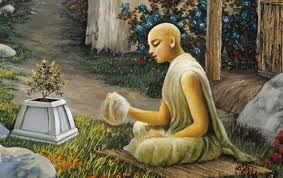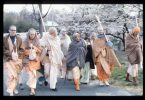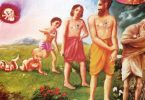Q. It is said that for Kali Yuga chanting is the recommended process for reaching Lord Krishna. But is this statement given in Bhagavad-Gita? My friend argues that only the statements given in Bhagavad-Gita and Vedas are acceptable without any argument, as Bhagavad-Gita came straight from Lord Krishna. But anyway I have strong belief in Srila Prabhupada and ISKCON, and I chant regularly the holy name of Lord Krishna.
Answer by Romapada Swami: Chanting Krishna’s Holy Names is recommended both in the Vedic texts as well as Bhagavad-gita and Puranas. The Hare Krishna Mahamantra is also specifically prescribed in the Upanishads, as well as the Pancaratras which are said to be particularly important for the present age.
Some References from Bhagavad-Gita:
In the Bhagavad-Gita, Krishna describes the great souls as constantly chanting His glories: ‘satatam kirtayanto mam’ – “Always chanting My glories, endeavoring with great determination, bowing down before Me, the great souls perpetually worship Me with devotion.” (BG 9.14) Glorification implies not some abstract theorizing but ‘chanting and praising the Supreme Lord’s holy name, His eternal form, His transcendental qualities and His uncommon pastimes.’
And again, throughout the Bhagavad-gita, performance of sacrifices is recommended and stressed as essential for all embodied living entities. Different types of sacrifices are also identified (e.g. Ch 4.25-33 ). The sacrifice specifically recommended for this age, and the most suitable and easy to perform, is the chanting of the Holy Names of Lord Hari. This is confirmed in the Bhagavad-gita as well when Krishna states yajnanam japa yajno ‘smi, “Of all sacrifices I am the chanting of the holy names [japa]” (BG 10.25)
Krishna also further directs us in the Bhagavad-gita — after concluding His discussion on the various types of sacrifice and stating that sacrifice culminates in transcendental knowledge, the Lord then directs us to approach a self-realized spiritual master to learn the Truth, render service unto such a spiritual master and inquire submissively. (Bg 4.34) The essential principles of spiritual perfection are outlined in the Bhagavad-gita in a nutshell – these principles are eternal and meant for all time and space, but to learn their specific application and details of execution in our lives, the guidance of self-realized souls, sadhu and guru, corroborated by explanations from other relevant scriptures, is indispensable. The bona fide spiritual master, who is well-versed with the conclusions of all scriptures, can prescribe us the appropriate means according to time, place, circumstances and individual needs.
Without such guidance, how are we to know the proper procedures to perform sacrifice in the present context of our daily life as recommended throughout the Gita? An authentic medical handbook may list all varieties of drugs and their uses, but in order to know what medicine will work for us and how exactly to administer it we have to take the help of an experienced physician, otherwise it could prove useless or even dangerous. Similarly, the prescriptions given in Bhagavad-Gita are to be followed as directed by Krishna, i.e. under the guidance of His authorized representatives.
Interestingly enough, this same argument which your friend presented was brought before Srila Prabhupada by Dr. Staal, Professor of Philosophy at the University of California, Berkeley — that Bhagavad-Gita and the Vedas do not directly recommend chanting. Srila Prabhupada extensively and thoroughly addresses this misconception with numerous quotes and references from Bhagavad-Gita as well as the Vedas and puranas. I invite you to go through this unusual and interesting exchange of letters between Prof. Staal and Srila Prabhupada, now published in the book “Science of Self Realization” under the title “Discovering the Roots.” After the back-and-forth debate, Srila Prabhupada concludes that discussion with this same final note: the appropriate medicine has to be prescribed by an experienced physician.
Through lexicographic interpretations, one may choose to conclude that Bhagavad-Gita could be indicating something else and thus altogether miss the spirit of its conclusion, but we resort to the authority of Sri Caitanya Mahaprabhu who was the greatest teacher of Bhagavad-Gita and Srimad Bhagavatam and who propagated the yuga-dharma of chanting the Hare Krishna Mahamantra as the ultimate conclusion of all scriptures. We can also rely on the practical effects of this chanting process in comparison to any other alternative process in the matter of systematically awakening one’s dormant love of God.
Some References from Upanishads and puranas:
The four Vedas, Upanishads, Mahabharata and the 18 puranas all belong to the same body of Vedic literature – they are all emanations from the breathing of the Supreme Lord. Srila Vyasadeva subdivided and compiled them for our benefit. Thus, to accept the Vedas (shruti) and reject the puranas (smriti) as less authentic is against the conclusions of the Vedas themselves. (See Digest 141 where we discussed this in greater detail) Of course, the superexcellent and indisputable authority of Bhagavad-Gita cannot be minimized – but this does not invalidate other scriptures, rather it implies that all other scriptural conclusions are to be understood and apparent contradictions resolved in light of the statements of Bhagavad-gita.
Although the standard principles in scriptures are eternal, they recommend specific processes suitable to particular time, place and circumstances. It is stated Srimad Bhagavatam (SB 12.3.52): “Whatever result was obtained in Satya-yuga by meditating on Vishnu, in Treta-yuga by performing sacrifices, and in Dvapara-yuga by serving the Lord’s lotus feet (worship of Deity in the temple) can be obtained in Kali-yuga simply by chanting the holy names of Lord Hari.” Almost identical statements are found also in the Vishnu purana, Padma purana and Brihan Naradiya purana.
The Brihan-naradiya Purana 3.8.126 states:
harer nama harer nama
harer namaiva kevalam
kalau nasty eva nasty eva
nasty eva gatir anyatha
“In this age of Kali there is no other means, no other means, no other means for self-realization than chanting the holy name, chanting the holy name, chanting the holy name of Lord Hari.”
The Hare Krishna Mahamantra is specifically mentioned in the Narada
Pancaratra and Kali-Santarana Upanishad:
hare krishna hare krishna krishna krishna hare hare
hare rama hare rama rama rama hare hare
ity sodasakam namnam kali kalmasa nasanam
natah parataropayah sarva vedeshu drishyate
“These sixteen words of the Hare Krishna mantra are especially meant for counteracting the sins of the age of Kali. To save oneself from the contamination of this age there is no alternative but to chant the Hare Krishna mantra. After searching through the entire Vedic literatures one cannot find a method of religion for this age so sublime as the chanting of Hare Krishna.” (Lord Brahma instructs Narada, Kali Santarana Upanishad 5-6)







